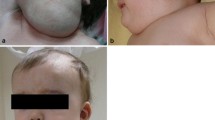Abstract
Background
Congenital anomalies are one component of the overwhelming surgical disease burden in low- and middle-income countries (LMICs). Lymphatic malformations (LMs) are a common congenital deformity of the head and neck in which the utilization of sclerotherapy may avoid surgery and yield superior outcomes. To be useful in LMICs, sclerosing agents must be widely available, inexpensive, and effective.
Methods
A retrospective review of 10 pediatric patients with macrocystic or mixed LMs who were treated with self-compounded doxycycline sclerotherapy at Rwanda’s Central University Teaching Hospital of Kigali was performed. Doxycycline oral tablets were crushed by hand, mixed with normal saline at a concentration of doxycycline 10 mg/mL, and injected directly into LMs of the head and neck.
Results
Ten pediatric patients underwent 21 sclerotherapy sessions with a mean of 2.1 sessions per patient (SD 1.3, range 1–5). Of the 8 patients that were seen in follow-up, all achieved at least 80% resolution, 6 of 8 achieved 100% resolution, and none required surgery. One patient developed an infection at the injection site which resolved with antibiotics.
Conclusions
Self-compounded doxycycline sclerotherapy is a safe, effective, and widely available treatment option for sclerotherapy of LMs in LMICs.

Similar content being viewed by others
References
WHO (World Health Organization) (2013) Global health estimates for deaths by cause, age, and sex for years 2000–2011. WHO, Geneva
Kennedy TL, Whitaker M, Pellitteri P, Wood WE (2001) Cystic hygroma/lymphangioma: a rational approach to management. Laryngoscope 111:1929–1937
Ethunandan M, Mellor TK (2006) Haemangiomas and vascular malformations of the maxillofacial region-a review. Br J Oral Maxillofac Surg 44(4):263–272
Curran AJ, Malik N, McShane D et al (1996) Surgical management of lymphangiomas in adults. J Laryngol Otol 110(6):586–589
Kang GC, Song C (2008) Forty-one cervicofacial vascular anomalies and their surgical management: retrospection and review. Ann Acad Med Singap 37:165–179
Cahill AM, Nijs EL (2011) Pediatric vascular malformations: pathophysiology, diagnosis, and the role of interventional radiology. Cardiovasc Intervent Radiol 34:691–704
Smith MC, Zimmerman MB, Burke DK et al (2009) Efficacy and safety of OK-342 immunotherapy of lymphatic malformations. Laryngoscope 119(1):107–115
Smith RJ (2004) Lymphatic malformations. Lymphat Res Biol 2(1):25–31
Perkins JA, Manning SC, Tempero RM et al (2010) Lymphatic malformations: review of current treatment. Otolaryngol Head Neck Surg 142:795–803
De Serres LM, Sie KC, Richardson MA (1995) Lymphatic malformations of the head and neck. A proposal for staging. Arch Otolaryngol Head Neck Surg 121(5):577–582
Molitch HI, Unger EC, Witte CL et al (1995) Percutaneous sclerotherapy of lymphangiomas. Radiology 194:343–347
Dubois J, Garel L, Abela A, Laberge L et al (1997) Lymphangiomas in children: percutaneous sclerotherapy with an alcoholic solution of zein. Radiology 204:651–654
Gigue CM, Bauman NM, Sato Y et al (2002) Treatment of lymphangiomas with OK-342 (Picibinal) Sclerotherapy: a prospective multi-institutional trial. Arch Otolaryngol Head Neck Surg 128:1137–1144
Waner M (2018) Multidisciplinary approach to the management of lymphatic malformations of the head and neck. Otolaryngol Clin North Am 51(1):159–172
Balakrishnan K, Edwards TC, Perkins JA (2012) Functional and symptom impacts of pediatric head and neck lymphatic malformations: developing a patient-derived instrument. Otolaryngol Head Neck Surg 147:925–931
Cheng J, Liu B, Farjat AE et al (2017) The public health burden of lymphatic malformations in children: national estimates in the United States, 2000–2009. Lymphat Res Biol 15(3):241–245
Meara JG, Leather AJ, Hagander L et al (2015) Global surgery 2030: evidence and solutions for achieving health, welfare, and economic development: the Lancet Commission on Global Surgery. Lancet 386:569–624
Poldervaart MT, Breugem CC, Speleman L et al (2009) Treatment of lymphatic malformations with OK-342 (Picibanil): review of the literature. J Craniofac Surg 20:1159–1162
Shiels WE 2nd, Kang DR, Murakami JW, Hogan MJ, Wiet GJ (2009) Percutaneous treatment of lymphatic malformations. Otolaryngol Head Neck Surg 141(2):219–224. https://doi.org/10.1016/j.otohns.2009.04.001
Peters DA, Courtemanche DJ, Heran MK et al (2006) Treatment of cystic lymphatic vascular malformations with OK-435 sclerotherapy. Plast Reconstr Surg 118:1441–1446
WHO (World Health Organization) (2012) “Congenital Anomalies.” Fact Sheet No. 370. WHO, Geneva
Hurewitz AN, Lidonicci K, Wu CL et al (1994) Histologic changes of doxycycline pleurodesis in rabbits. Effect of concentration and pH. Chest 106(4):1241–1245
Alomari AI, Karian VE, Lord DJ (2006) Percutaneous sclerotherapy for lymphatic malformations: a retrospective analysis of patient-evaluated improvement. J Vasc Interv Radiol 17(10):1639–1648
Bloom DC, Perkins JA, Manning SC (2004) Management of lymphatic malformations. Curr Opin Otolaryngol Head Neck Surg 12(6):500–504
Bagrodia N, Defnet AM, Kandel JJ (2015) Management of lymphatic malformations in children. Curr Opin Pediatr 27(3):356–363
Jamal N, Ahmed S, Miller T et al (2012) Doxycycline sclerotherapy for pediatric head and neckmacrocystic lymphaticmalformations: a case series and review of the literature. Int J Pediatr Otorhinolaryngol 76(8):1127–1131
Cahill AM, Nijs E, Ballah D et al (2011) Percutaneous sclerotherapy in neonatal and infant head and neck lymphatic malformations: a single center experience. J Pediatr Surg 46(11):2083–2095
Burrows PE, Mitri RK, Alomari A et al (2008) Percutaneous sclerotherapy of lymphatic malformations with doxycycline. Lymphat Res Biol 6(3–4):209–216
Krishnaswami S, Nwomeh BC, Ameh EA (2016) The pediatric surgery workforce in low- and middle-income countries: problems and priorities. Semin Pediatr Surg 25(1):32–42
Butler EK, Tran TM, Nagarajan N et al. (2017) Epidemiology of pediatric surgical needs in low-income countries. PLoS One 3: 12(3)
Ozgediz D, Riviello R (2008) The ‘other’ neglected diseases in global public health: surgical conditions in sub-Saharan Africa. PLoS Med 5:6
Cheng J (2015) Doxycycline sclerotherapy in children with head and neck lymphatic malformations. J Pediatr Surg 50(12):2143–2146
Acknowledgements
This study was granted Institutional Review Board approval by the Central University Teaching Hospital of Kigali.
Funding
None
Author information
Authors and Affiliations
Corresponding author
Ethics declarations
Conflict of interest
The author declared that they have no conflict of interest.
Additional information
Publisher's Note
Springer Nature remains neutral with regard to jurisdictional claims in published maps and institutional affiliations.
Rights and permissions
About this article
Cite this article
Shaye, D.A., Burks, C.A., Gadkaree, S.K. et al. Self-compounded Doxycycline Sclerotherapy for the Treatment of Lymphatic Malformations in Low-Resource Settings. World J Surg 44, 3616–3619 (2020). https://doi.org/10.1007/s00268-020-05667-z
Accepted:
Published:
Issue Date:
DOI: https://doi.org/10.1007/s00268-020-05667-z




